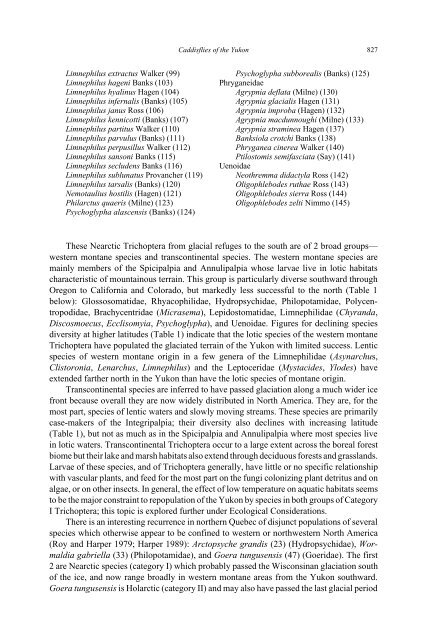Caddisflies of the Yukon - Department of Biological Sciences ...
Caddisflies of the Yukon - Department of Biological Sciences ...
Caddisflies of the Yukon - Department of Biological Sciences ...
Create successful ePaper yourself
Turn your PDF publications into a flip-book with our unique Google optimized e-Paper software.
Limnephilus extractus Walker (99)<br />
Limnephilus hageni Banks (103)<br />
Limnephilus hyalinus Hagen (104)<br />
Limnephilus infernalis (Banks) (105)<br />
Limnephilus janus Ross (106)<br />
Limnephilus kennicotti (Banks) (107)<br />
Limnephilus partitus Walker (110)<br />
Limnephilus parvulus (Banks) (111)<br />
Limnephilus perpusillus Walker (112)<br />
Limnephilus sansoni Banks (115)<br />
Limnephilus secludens Banks (116)<br />
Limnephilus sublunatus Provancher (119)<br />
Limnephilus tarsalis (Banks) (120)<br />
Nemotaulius hostilis (Hagen) (121)<br />
Philarctus quaeris (Milne) (123)<br />
Psychoglypha alascensis (Banks) (124)<br />
<strong>Caddisflies</strong> <strong>of</strong> <strong>the</strong> <strong>Yukon</strong> 827<br />
Psychoglypha subborealis (Banks) (125)<br />
Phryganeidae<br />
Agrypnia deflata (Milne) (130)<br />
Agrypnia glacialis Hagen (131)<br />
Agrypnia improba (Hagen) (132)<br />
Agrypnia macdunnoughi (Milne) (133)<br />
Agrypnia straminea Hagen (137)<br />
Banksiola crotchi Banks (138)<br />
Phryganea cinerea Walker (140)<br />
Ptilostomis semifasciata (Say) (141)<br />
Uenoidae<br />
Neothremma didactyla Ross (142)<br />
Oligophlebodes ruthae Ross (143)<br />
Oligophlebodes sierra Ross (144)<br />
Oligophlebodes zelti Nimmo (145)<br />
These Nearctic Trichoptera from glacial refuges to <strong>the</strong> south are <strong>of</strong> 2 broad groups—<br />
western montane species and transcontinental species. The western montane species are<br />
mainly members <strong>of</strong> <strong>the</strong> Spicipalpia and Annulipalpia whose larvae live in lotic habitats<br />
characteristic <strong>of</strong> mountainous terrain. This group is particularly diverse southward through<br />
Oregon to California and Colorado, but markedly less successful to <strong>the</strong> north (Table 1<br />
below): Glossosomatidae, Rhyacophilidae, Hydropsychidae, Philopotamidae, Polycentropodidae,<br />
Brachycentridae (Micrasema), Lepidostomatidae, Limnephilidae (Chyranda,<br />
Discosmoecus, Ecclisomyia, Psychoglypha), and Uenoidae. Figures for declining species<br />
diversity at higher latitudes (Table 1) indicate that <strong>the</strong> lotic species <strong>of</strong> <strong>the</strong> western montane<br />
Trichoptera have populated <strong>the</strong> glaciated terrain <strong>of</strong> <strong>the</strong> <strong>Yukon</strong> with limited success. Lentic<br />
species <strong>of</strong> western montane origin in a few genera <strong>of</strong> <strong>the</strong> Limnephilidae (Asynarchus,<br />
Clistoronia, Lenarchus, Limnephilus) and <strong>the</strong> Leptoceridae (Mystacides, Ylodes) have<br />
extended far<strong>the</strong>r north in <strong>the</strong> <strong>Yukon</strong> than have <strong>the</strong> lotic species <strong>of</strong> montane origin.<br />
Transcontinental species are inferred to have passed glaciation along a much wider ice<br />
front because overall <strong>the</strong>y are now widely distributed in North America. They are, for <strong>the</strong><br />
most part, species <strong>of</strong> lentic waters and slowly moving streams. These species are primarily<br />
case-makers <strong>of</strong> <strong>the</strong> Integripalpia; <strong>the</strong>ir diversity also declines with increasing latitude<br />
(Table 1), but not as much as in <strong>the</strong> Spicipalpia and Annulipalpia where most species live<br />
in lotic waters. Transcontinental Trichoptera occur to a large extent across <strong>the</strong> boreal forest<br />
biome but <strong>the</strong>ir lake and marsh habitats also extend through deciduous forests and grasslands.<br />
Larvae <strong>of</strong> <strong>the</strong>se species, and <strong>of</strong> Trichoptera generally, have little or no specific relationship<br />
with vascular plants, and feed for <strong>the</strong> most part on <strong>the</strong> fungi colonizing plant detritus and on<br />
algae, or on o<strong>the</strong>r insects. In general, <strong>the</strong> effect <strong>of</strong> low temperature on aquatic habitats seems<br />
to be <strong>the</strong> major constraint to repopulation <strong>of</strong> <strong>the</strong> <strong>Yukon</strong> by species in both groups <strong>of</strong> Category<br />
I Trichoptera; this topic is explored fur<strong>the</strong>r under Ecological Considerations.<br />
There is an interesting recurrence in nor<strong>the</strong>rn Quebec <strong>of</strong> disjunct populations <strong>of</strong> several<br />
species which o<strong>the</strong>rwise appear to be confined to western or northwestern North America<br />
(Roy and Harper 1979; Harper 1989): Arctopsyche grandis (23) (Hydropsychidae), Wormaldia<br />
gabriella (33) (Philopotamidae), and Goera tungusensis (47) (Goeridae). The first<br />
2 are Nearctic species (category I) which probably passed <strong>the</strong> Wisconsinan glaciation south<br />
<strong>of</strong> <strong>the</strong> ice, and now range broadly in western montane areas from <strong>the</strong> <strong>Yukon</strong> southward.<br />
Goera tungusensis is Holarctic (category II) and may also have passed <strong>the</strong> last glacial period
















